
Text B Nonverbal Communication
Text B Nonverbal Communication
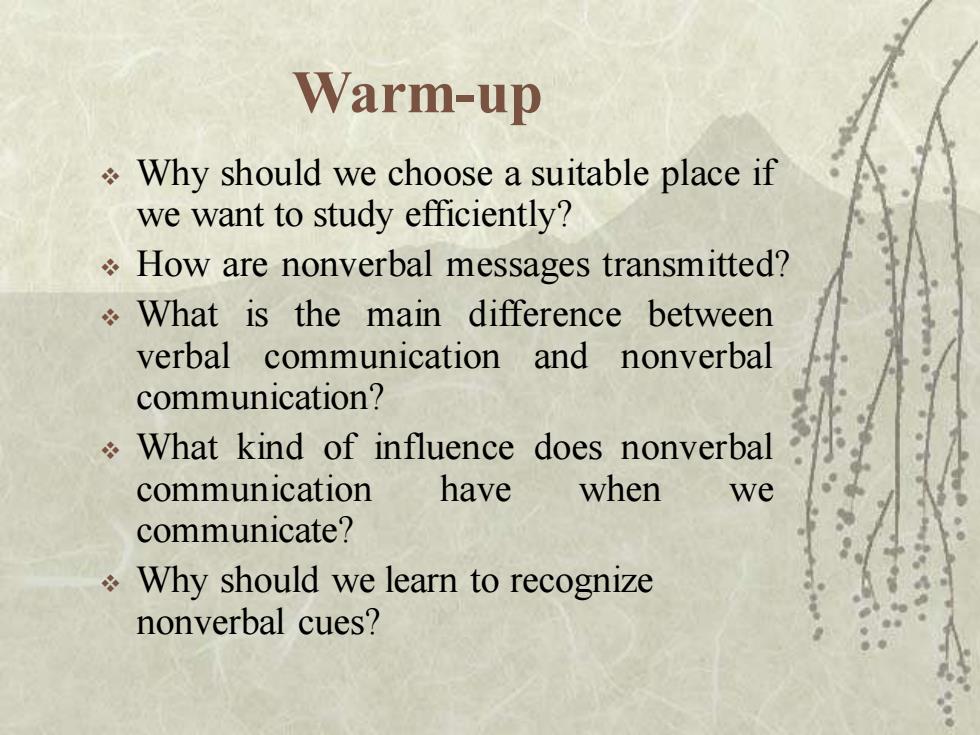
Warm-up Why should we choose a suitable place if we want to study efficiently? How are nonverbal messages transmitted? What is the main difference between verbal communication and nonverbal communication? What kind of influence does nonverbal communication have when we communicate? Why should we learn to recognize nonverbal cues?
Warm-up ❖ Why should we choose a suitable place if we want to study efficiently? ❖ How are nonverbal messages transmitted? ❖ What is the main difference between verbal communication and nonverbal communication? ❖ What kind of influence does nonverbal communication have when we communicate? ❖ Why should we learn to recognize nonverbal cues?
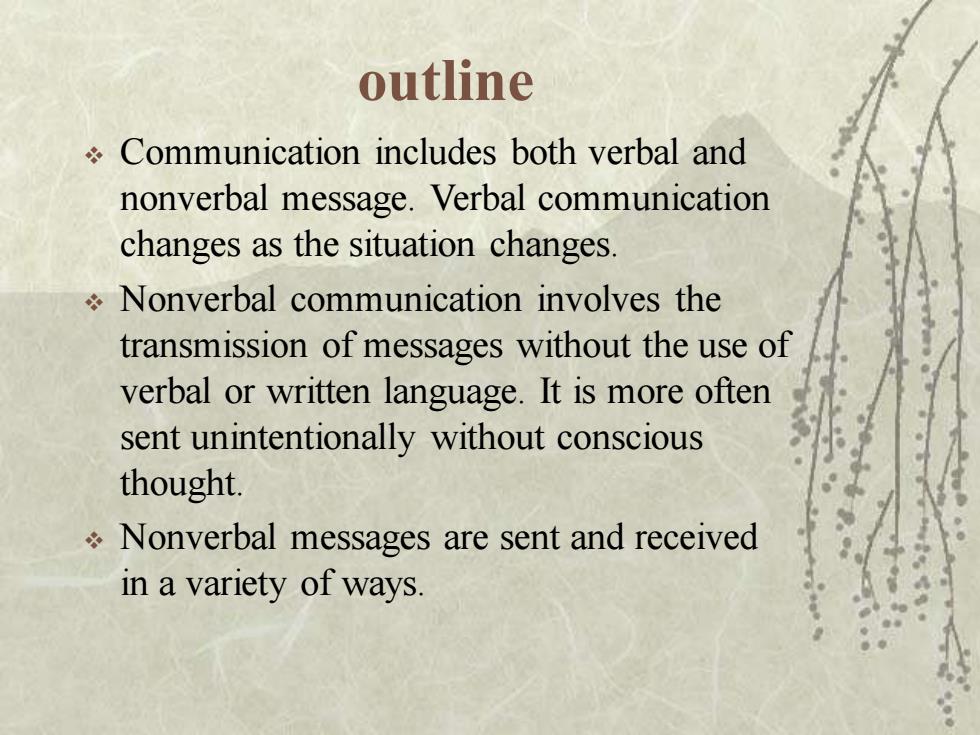
outline *Communication includes both verbal and nonverbal message.Verbal communication changes as the situation changes. Nonverbal communication involves the transmission of messages without the use of verbal or written language.It is more often sent unintentionally without conscious thought. Nonverbal messages are sent and received in a variety of ways
outline ❖ Communication includes both verbal and nonverbal message. Verbal communication changes as the situation changes. ❖ Nonverbal communication involves the transmission of messages without the use of verbal or written language. It is more often sent unintentionally without conscious thought. ❖ Nonverbal messages are sent and received in a variety of ways
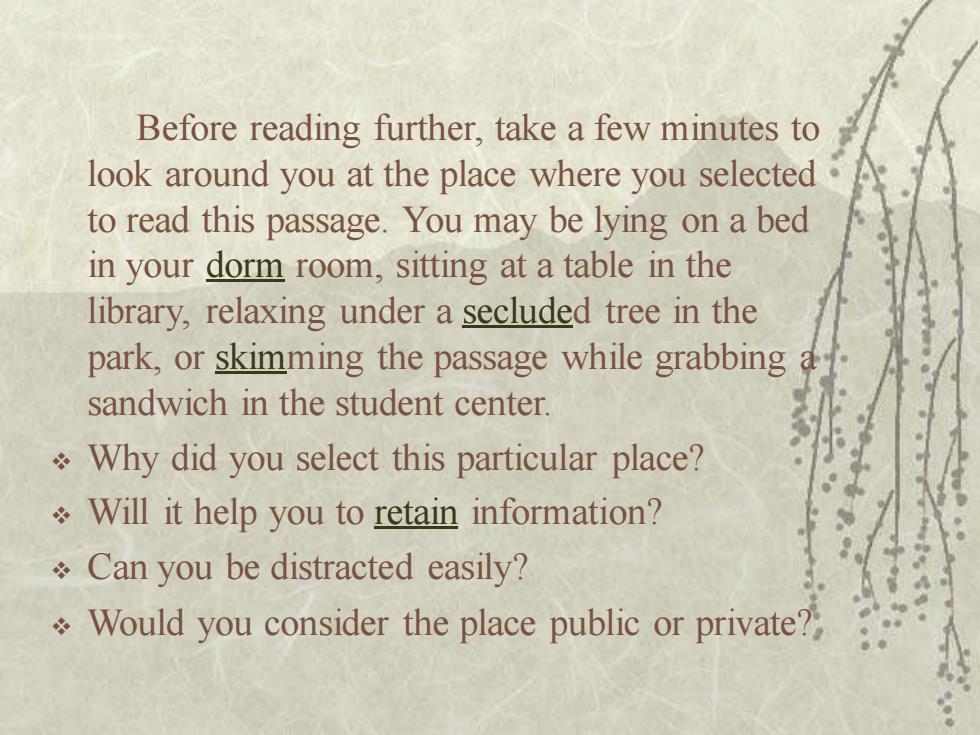
Before reading further,take a few minutes to look around you at the place where you selected to read this passage.You may be lying on a bed in your dorm room,sitting at a table in the library,relaxing under a secluded tree in the park,or skimming the passage while grabbing a sandwich in the student center. Why did you select this particular place? Will it help you to retain information? Can you be distracted easily? Would you consider the place public or private?
Before reading further, take a few minutes to look around you at the place where you selected to read this passage. You may be lying on a bed in your dorm room, sitting at a table in the library, relaxing under a secluded tree in the park, or skimming the passage while grabbing a sandwich in the student center. ❖ Why did you select this particular place? ❖ Will it help you to retain information? ❖ Can you be distracted easily? ❖ Would you consider the place public or private?
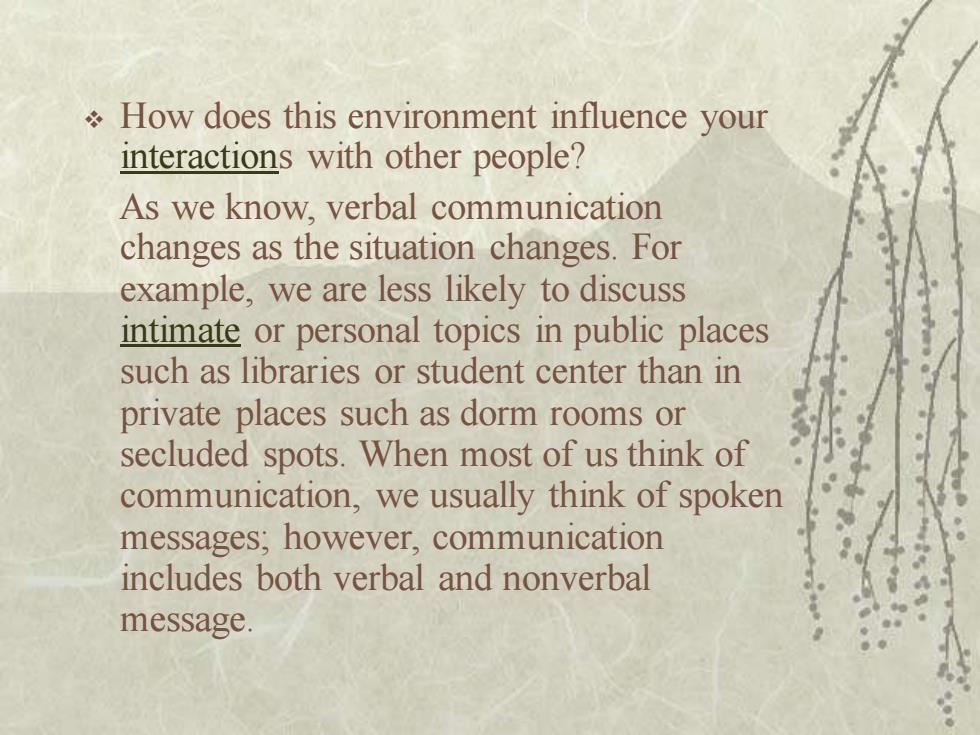
How does this environment influence your interactions with other people? As we know,verbal communication changes as the situation changes.For example,we are less likely to discuss intimate or personal topics in public places such as libraries or student center than in private places such as dorm rooms or secluded spots.When most of us think of communication,we usually think of spoken messages;however,communication includes both verbal and nonverbal message
❖ How does this environment influence your interactions with other people? As we know, verbal communication changes as the situation changes. For example, we are less likely to discuss intimate or personal topics in public places such as libraries or student center than in private places such as dorm rooms or secluded spots. When most of us think of communication, we usually think of spoken messages; however, communication includes both verbal and nonverbal message
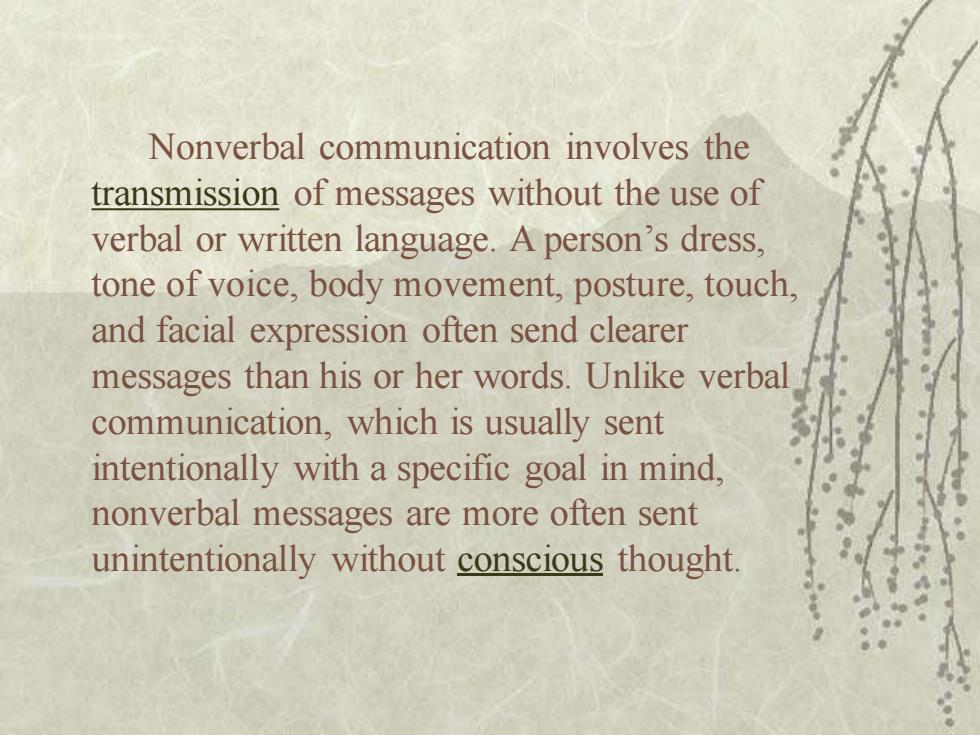
Nonverbal communication involves the transmission of messages without the use of verbal or written language.A person's dress, tone of voice,body movement,posture,touch, and facial expression often send clearer messages than his or her words.Unlike verbal communication,which is usually sent intentionally with a specific goal in mind, nonverbal messages are more often sent unintentionally without conscious thought
Nonverbal communication involves the transmission of messages without the use of verbal or written language. A person’s dress, tone of voice, body movement, posture, touch, and facial expression often send clearer messages than his or her words. Unlike verbal communication, which is usually sent intentionally with a specific goal in mind, nonverbal messages are more often sent unintentionally without conscious thought

For example,you may have been in a situation such as a job interview in which a recruiter said,"Relax,I just want to get to know you a little better,"and you wondered, "How did he know that I was anxious?" Later,you may have remembered perspiring, wringing your hands,playing with your watch,or of our outward manifestations,we can give impressions that we'd like to avoid
For example, you may have been in a situation such as a job interview in which a recruiter said, “Relax, I just want to get to know you a little better,” and you wondered, “How did he know that I was anxious?” Later, you may have remembered perspiring, wringing your hands, playing with your watch, or of our outward manifestations, we can give impressions that we’d like to avoid
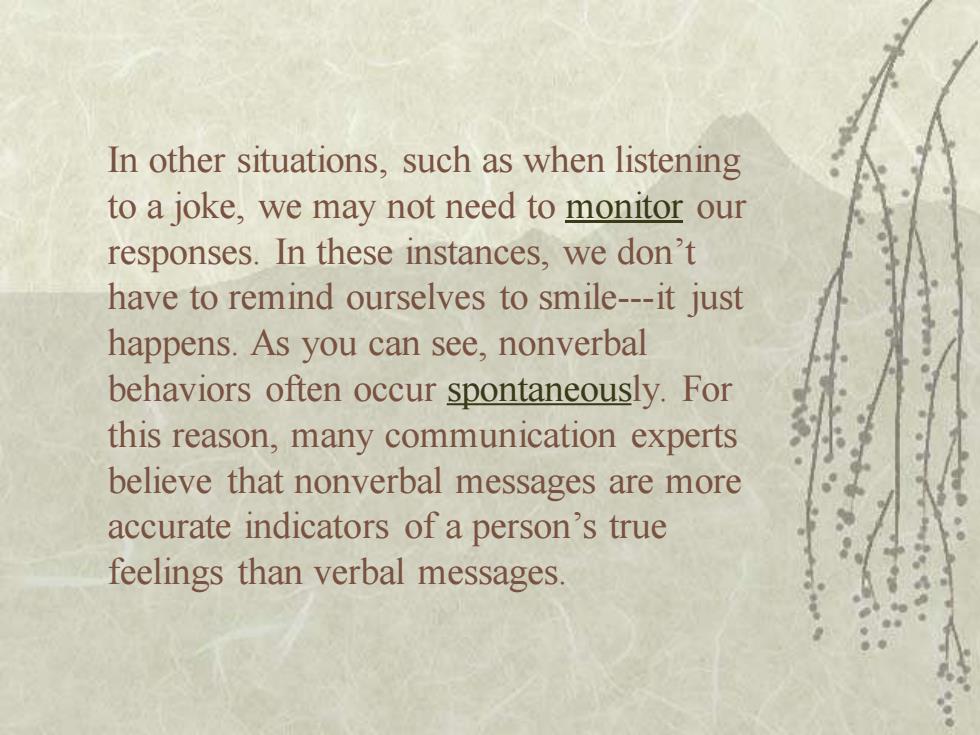
In other situations,such as when listening to a joke,we may not need to monitor our responses.In these instances,we don't have to remind ourselves to smile---it just happens.As you can see,nonverbal behaviors often occur spontaneously.For this reason,many communication experts believe that nonverbal messages are more accurate indicators of a person's true feelings than verbal messages
In other situations, such as when listening to a joke, we may not need to monitor our responses. In these instances, we don’t have to remind ourselves to smile---it just happens. As you can see, nonverbal behaviors often occur spontaneously. For this reason, many communication experts believe that nonverbal messages are more accurate indicators of a person’s true feelings than verbal messages
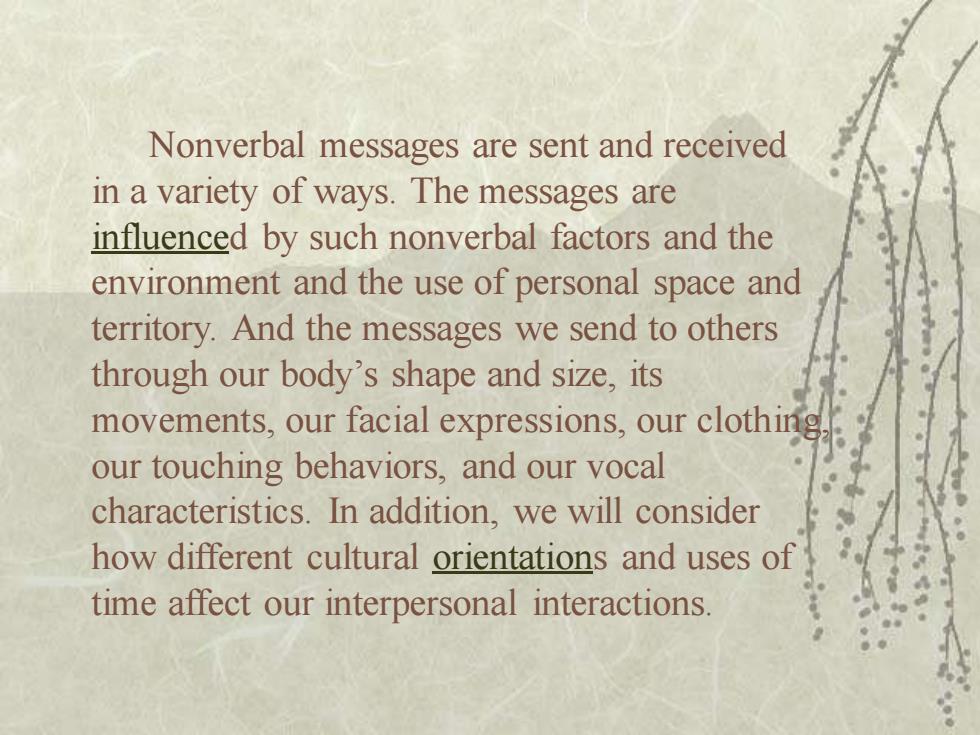
Nonverbal messages are sent and received in a variety of ways.The messages are influenced by such nonverbal factors and the environment and the use of personal space and territory.And the messages we send to others through our body's shape and size,its movements,our facial expressions,our clothing. our touching behaviors,and our vocal characteristics.In addition,we will consider how different cultural orientations and uses of time affect our interpersonal interactions
Nonverbal messages are sent and received in a variety of ways. The messages are influenced by such nonverbal factors and the environment and the use of personal space and territory. And the messages we send to others through our body’s shape and size, its movements, our facial expressions, our clothing, our touching behaviors, and our vocal characteristics. In addition, we will consider how different cultural orientations and uses of time affect our interpersonal interactions
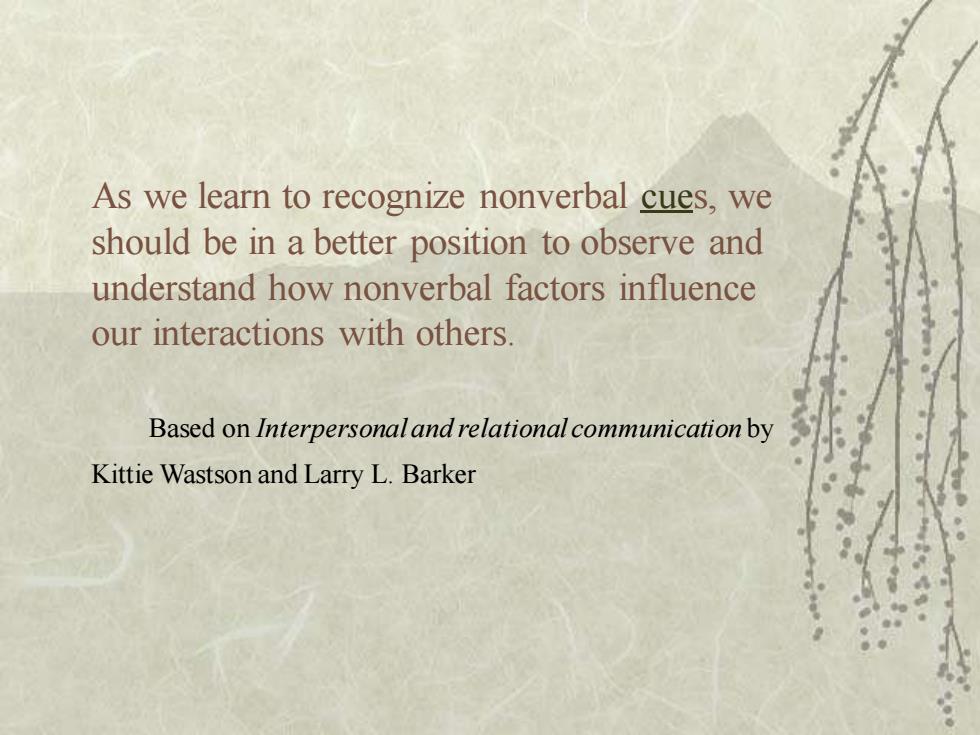
As we learn to recognize nonverbal cues,we should be in a better position to observe and understand how nonverbal factors influence our interactions with others. Based on Interpersonal and relational communication by Kittie Wastson and Larry L.Barker
As we learn to recognize nonverbal cues, we should be in a better position to observe and understand how nonverbal factors influence our interactions with others. Based on Interpersonal and relational communication by Kittie Wastson and Larry L. Barker